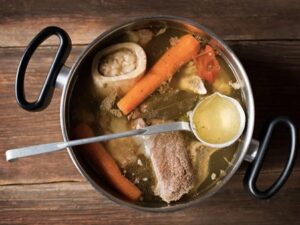
Meaty bones, cartilage, connective tissue, and marrow are packed with vitamins, minerals, and proteins. Bone and connective tissue, "collagen" broths and stocks are a staple in almost every cuisine around the globe, forming the basis of traditional terrines, sauces, gravies, soups, and stews. These stocks are a rich source of proteins and amino acids such as collagen, glutamine, proline, hydroxyproline, and glycine, and provide these nutrients in a form that is easily utilised by the body. The amino acid profile of broth helps to offset the amino acid profile of muscle meat–essential for long-term health. "Bone" broth is part of a nose-to-tail, ancestral diet, and every culture on earth has had a bone or meat stock or broth in its diet. But how exactly can bone broth help our health? Here are our top 10 reasons why everyone should be drinking bone broth, recipe and instructions, and an explanation of the differences between bone/meat broths and stocks.
Straining your eyes? You can listen to this automated AI version of the article here:
Contents
- Immune system support
- Supports a healthy gut
- Supports strong bones
- Gives you glowing skin
- Supports energy and blood sugar balance
- Supports healthy digestion
- Supports healthy joints
- Supports weight management
- Improves sleep
- Enhances detoxification
1. Immune system support
It is often said that chicken soup will fix a cold, and there is some truth to that because the amino acids found in bone broth have been shown to support a healthy immune response. Research on chicken broth has found that these effects may support the body to cope with upper respiratory tract infections. Other research shows that the 40-50% saturated animal fats in broth support the immune system and the serum lipid transport proteins in responding to infection.

2. Supports a healthy gut
Gut health is dependent on the gut microbiome and the healthy functioning of the mucosal layer and the cells of the gut lining. If these are compromised, undigested food particles may move into the bloodstream. This leads to an immune system response causing food sensitivities and digestive complaints. Bone broth contains essential amino acids, particularly glutamic acid, collagen, and trace minerals. These nutrients support healthy gut function, feed the cells of the gut wall and the microbiota, and support the regeneration of the protective mucosal layer. This supports those with common complaints such as bloating and wind and alleviates sensitivities. A study in mice with damage to their gut lining found that the ad libitum intake of beef bone broth decreased colon tissue damage and corresponding blood markers.
3. Supports strong bones
Around 50% of our bones are collagen. Collagen peptides (proteins) are thought to hold potential for maintaining bone mineral density and guarding against bone weakening. Research has shown that collagen peptides support osteoblasts, which synthesise new bone. Collagen intake may support bone mass as we age.
4. Gives you glowing skin
Many skincare companies add collagen to their products for healthy aging benefits. One of the most abundant proteins found within the human body, collagen helps form tissue that gives our skin smoothness, elasticity, and a youthful appearance. Collagen, naturally occurring in bone broth, is rich in proline, a well-researched amino acid that supports skin renewal. The amino acids in collagen are the building blocks of collagen production. Collagen peptides bind to the cells that help make collagen, supporting collagen production, and they also function as antioxidants. Several randomized controlled trials found that giving standard care in combination with a collagen hydrolysate supplement resulted in significantly faster recovery than giving only standard care. Pairing vitamin C with your bone broth can have a lasting impact on the health and appearance of your skin. Collagen also contains hyaluronic acid, which reduces the appearance of fine lines and wrinkles and supports firmer skin.
5. Supports energy and blood sugar balance
Traditional Chinese modalities use broth to build blood, qi, and essence. Adding a hunk of red meat to your broth and/or making sure your bones and joints have meat and connective tissue, especially tendons, provides additional nutrients that support energy production in the body. The amino acid, glycine, that is found in gelatin-rich broth has been shown to support sugar levels in the blood, helping to stabilise energy. Glycine can also support energy availability. Even though there is not quite the amount of minerals and electrolytes in broth that it is heralded for, there is still enough to supplement mineral intake, which helps to keep the body well hydrated, maintain energy, and is essential for muscle, nerve, and a healthy brain.
6. Supports healthy digestion
The gelatin in bone broth attracts water, increasing enzymatic fluids in the digestive tract so that food may move through the stomach and intestines properly. This aids in proper digestion and absorption and supports healthy bowel movements. Gelatin has also been shown to support healthy stomach acid levels. Traditional cultures often add the gelatin from bone broth to children’s milk, to make it more digestible. Gelatin can be added to any food and is especially good at supporting the digestion of traditionally prepared grains, with corn being one of the only exceptions.
7. Supports healthy joints
This is where bone broth really shines…As we get older, we naturally experience wear and tear in our joints, and cartilage becomes damaged. The gelatin (cooked form of collagen) in bone broth is traditionally utilised to maintain cartilage and connective tissue, reduce stiffness in tendons and ligaments, and reduce friction. Some digested gelatin is denatured (broken down) enough to be absorbed in the small intestine, which is then used as building blocks in the maintenance of proteins and connective tissue. The collagen that is left undenatured supports immune cells to restore damaged cartilage.
Bone broth also contains proteoglycans, chiefly hyaluronic acid, glucosamine, and chondroitin sulfate, which provide cushioning and lubrication to our joint cartilage, skin, muscles, and bones, supporting regeneration and hydration. Our blood vessels also need collagen to remain supple.

8. Supports weight management
Because a meaty bone broth is an excellent source of nutrients, it is encouraged to drink during periods of fasting and recovery from illness. It fits in well with a high-fat, low-carb diet and may help to reduce signs of the ‘keto flu.’ As mentioned, it has been shown to support blood sugar balance, supporting healthy body weight and lean mass. The collagen in bone broth can also reduce the appearance of cellulite, which develops due to a lack of collagen-formed connective tissues.
9. Improves sleep
Bone broth is rich in glycine, an amino acid and neurotransmitter that supports the central nervous system. Glycine has been found to support sleep, reducing the amount of time it takes to fall asleep and improving morning fatigue.
10. Enhances detoxification
Bone broth contains nutrients needed to support cellular and liver detoxification. The nutrients in bone broth help detoxify the body by flushing out toxins, excess hormones, and other waste. The minerals in long-cooked bone broth also work as chelating agents, helping to eliminate heavy metals such as mercury and lead.
Mineral Content
Contrary to popular belief, a broth made solely with bones does not necessarily contain an abundance of minerals, like calcium, potassium, and magnesium. This is because bones are very hard compounds, and they do not give up their stash of minerals easily. Also, although bones contain most of the calcium in an animal’s body, you’d have to eat at least 50 g of bone to get one day’s calcium requirements! Adding vegetables and herbs/spices can enhance the taste and increase the mineral content, but it can also increase the amount of anti-nutrients, such as oxalic acid, in the broth, so be sparing if those things are an issue for you. The mineral content of a bone broth without vegetables can be slightly improved by adding an acid medium, like apple cider vinegar, to the cooking water. The type of animal, the type of bone, and the cooking time can influence the amount of minerals in your finished broth. The upshot is that you cannot necessarily rely on bone broth alone to provide you with your daily calcium requirements. If you really want to get some more bone and teeth-building minerals, gnaw on some chicken bones after cooking, or sterilise and grind bones to make a bone meal. Traditional ruminant or pork bone broths in Asia cook for a minimum of 48 hours. This may increase calcium content of the broth, but more research is needed in the area of bone broths and minerals. Bone broth really is more about the collagen, amino acids like glycine, hydroxyproline, glutamine, and arginine, and its other compounds such as glucosamine, chondroitin, and hyaluronic acid.
Stock vs. Broth
- Ingredients: Meat (chicken, beef, or fish), vegetables (optional), and seasonings.
- Preparation: Simmered for a shorter period, typically a couple of hours.
- Consistency: Thin and liquid.
- Flavor: More pronounced and seasoned, often used as a base for soups or enjoyed as is.
- Examples: Chicken broth, beef broth, potassium broth (potatoes and other veg).
- Ingredients: Bones with connective tissue (often with some meat and vegetables).
- Preparation: Simmered for a longer time, sometimes up to 8 hours or more, to extract collagen.
- Consistency: Thicker and richer due to the gelatin from the collagen, may gel when cooled.
- Flavor: Milder and less seasoned than broth, often used as a base for other dishes.
- Examples: Chicken stock, beef stock.
- While often referred to as broth, bone broth is technically a stock due to its preparation method of simmering bones for an extended period.
- It’s particularly rich in collagen and is known for its health benefits.
- Adding tendons to a “bone broth” makes it far more gelatinous and collagen rich than bones alone, and the broth requires a lot less cooking time to get a thicker consistency.
Cooking broth
Many recommend a shorter cooking time if you suffer from histamine intolerance. A shorter-cooked, meatier broth is the centre of the Gut and Psychology Syndrome diet, and this may be more appropriate for children who have gut/brain axis issues.
One thing about bone broth is the oft-discussed potential for heavy metal toxicity. Research has shown that there may be very little in the way of toxic metals extracted through the long, slow cooking of bone broth, even with added vinegar; however, it may pay to get bones from quality sources and, preferably, organic, but definitely pasture-fed and finished and free-range.
Homemade Bone Broth Recipe
- A selection of bones with meat and connective tissue still attached – joints, marrow bones (cut), feet, chicken carcass, etc
- OR a whole chicken (flesh can be eaten for a meal if shorter cooked)
- 2 beef tendons per litre of water (ask your local butcher)
- 1 onion (skin on or off)
- 1 Carrot chopped
- 1-2 Celery stalks or pieces of celeriac
- 10-20mL of apple cider vinegar per litre of water (as taste desires – the more acidic, the more it can degrade the bone)
- Sea salt to taste (approx. ½-1 teaspoon per litre of water)
Optional:
- A piece of meat (cheaper cut like chuck steak or tastier organ like heart) or a pork belly, which is a traditional Chinese medicine recommendation for women
- A small number of other vegetable off-cuts (these can be placed in the freezer and stored until you are making a broth)
- Some fresh parsley or herb of choice
- Chopped fresh ginger bulb
- ½ teaspoon of peppercorns
Directions
Slow cooker:
The easiest, “set-and-forget” way to cook broth is to do so, overnight or for longer, in a slow cooker on low heat. This negates the need for a large pot on the stove that you have to constantly watch.
Pot on stove:
- Place all ingredients (except fresh parsley) into a large pot and fill with water to cover
- Bring to the boil and remove any scum (froth) that rises to the surface
- Cover and reduce to a simmer for 6-24 hours (shorter for fish and chicken, longer for pork, and longest for beef, etc.)
- 20 minutes before turning the heat off, add parsley and season accordingly
- Don’t remove the fat. Animal fats are very nourishing and complement the golden liquid very well.
- Once cooled (warm, not cold), remove vegetables, squeeze out any liquid, and strain
- Remove the connective tissue and tendons and use in soups and casseroles
- Pour into containers and store in the fridge or freezer
- When cold, broth should be wobbly like jelly
Broth is a wonderful addition for people who cannot have large amounts of meat in their diet, who are recuperating from illness, who have a seasonal illness, or who value a nutrient dense diet. Bone broth is a simple addition to any diet and should be a staple in your kitchen. It can be used in the same way that you would use water to cook grains, as a base in a soup or stew, in the making of terrine, or simply enjoyed as a warm, nourishing drink.
FAQs
What are the benefits of drinking bone broth?
The benefits of drinking bone broth include supporting the immune system, promoting healthy digestion, nourishing the skin, supporting joint health, aiding in weight management, improving sleep quality, and enhancing detoxification.
How does bone broth support gut health?
Bone broth supports gut health by providing essential amino acids, collagen, and trace minerals that nourish the gut lining, support the gut microbiome, and promote the regeneration of the protective mucosal layer, helping to alleviate digestive complaints and food sensitivities.

